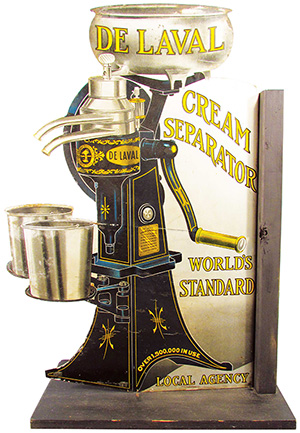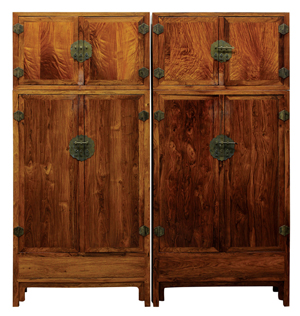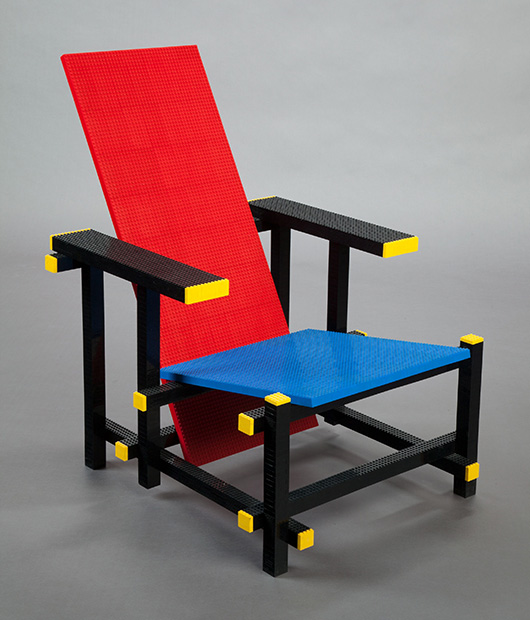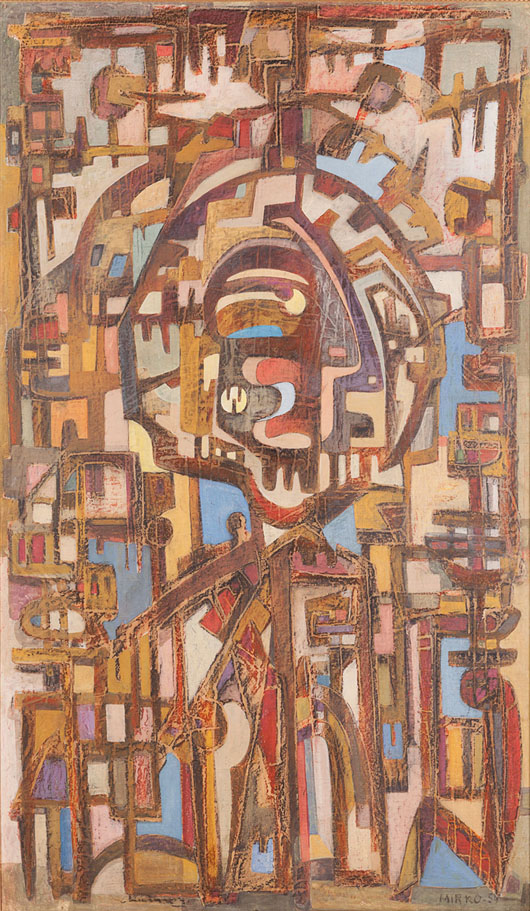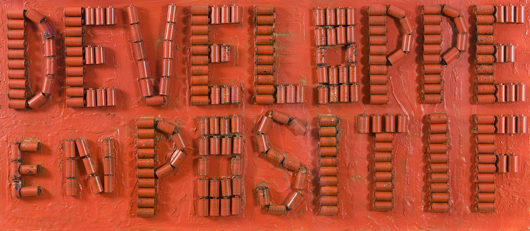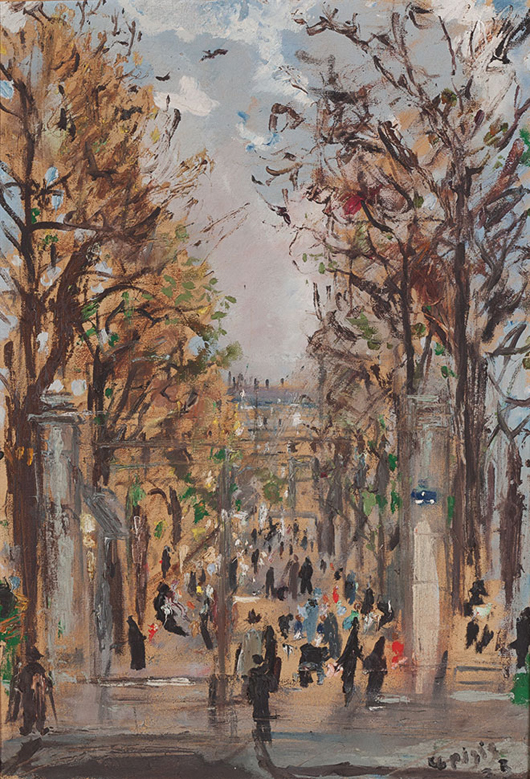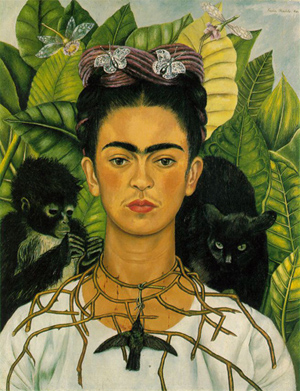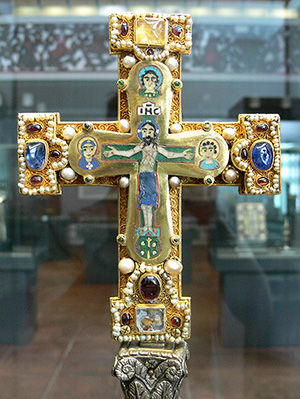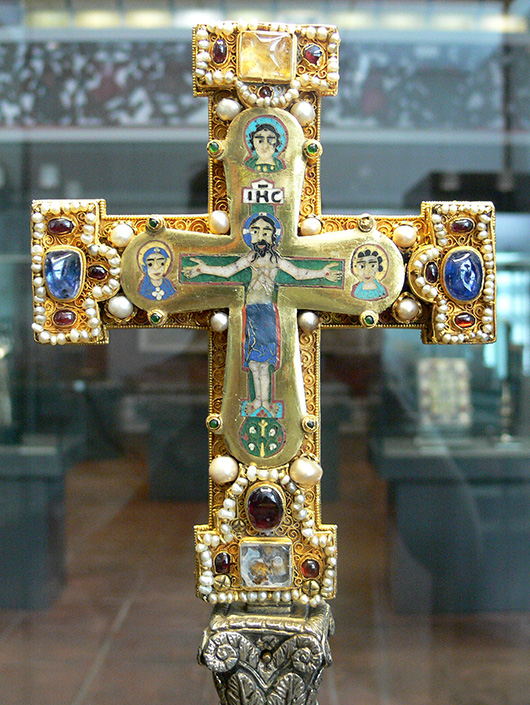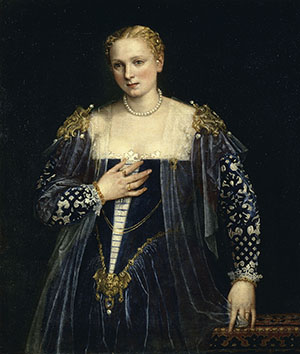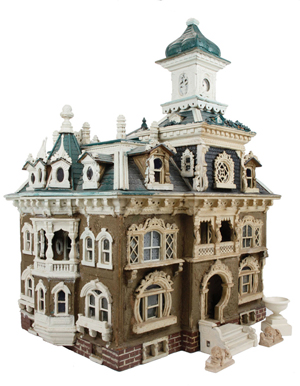
Extravagantly detailed Moorish Revival Christmas Garden House with stained, textured and etched window glazing. Est. $3,000-$5,000. Noel Barrett Auctions image. NEW HOPE, Pa. – Visionary collector, author and founder of the revered Washington Dolls’ House & Toy Museum, Flora Gill Jacobs (1918-2006) was a potent and influential force in the hobby of dollhouse and miniature collecting. Her devotion to the famed Washington, D.C., museum that played host to the children of presidents and diplomats helped bolster the dollhouse and miniatures hobby during the last quarter of the 20th century.
Inside the museum, which attracted some 20,000 visitors annually, were breathtaking displays of miniature residences, each one painstakingly decorated with luxe furnishings and tiny accessories. In 2004, Noel Barrett auctioned the museum’s collection under instruction from Mrs. Jacobs. Now, on April 11 and 12, collectors will have the opportunity to bid on the items Flora Gill Jacobs chose for her personal collection that was displayed in her elegant suburban residence. As before, Noel Barrett Auctions has been chosen to conduct the sale, with Internet live bidding through LiveAuctioneers.
“What is different about the April auction is that we’re selling the dollhouses and furnishings separately. At the museum sale, we left the dollhouses intact,” said Noel Barrett, owner of Noel Barrett Auctions. “We’ve organized it so that the dollhouse is sold first, followed by 20 or so lots of furnishings that decorated that particular house. This gives the dollhouse buyer the freedom to put their own stamp on the décor.”
Three grand and well-documented dollhouses occupy the top tier of the sale, the first being the celebrated South Jersey House (est. $12,000-$18,000), which was one of the museum’s top showpieces. This house, which launched the Jacobs collection when it was purchased in 1945, acquired its name because it came from an antiques dealer in the southern New Jersey town of Malaga. Thirteen years later, the South Jersey House served as the focal point of Jacobs’ first self-published children’s book, “The Doll House Mystery.” It was referenced in all subsequent books Jacobs authored, as well.
The three sides of the stately South Jersey House are graced with several styles of windows and crowned with a checker-painted mansard roof. The interior is comprised of four deep rooms separated by a hall on the first and second floors. The staircase with landing and two fireplace mantels are original features. The ceilings in the four main rooms have elaborate medallions with hooks for chandeliers. The house is offered with painted cast-iron fencing, a circular wood base and two urns. The elaborate array of furnishings will be offered in 42 subsequent lots.
The early to mid-19th-century English Baby House is a classic British form with finely crafted architectural details, a painstakingly hand-painted faux-brick exterior and interior walls covered in early papers. This house is pictured and discussed on Pages 161-163 of Jacobs’ 2005 reference “The Small World of Antique Dolls’ Houses.” It is estimated at $8,000-$12,000.
The third featured house is known as the Somerville Mansion and replicates an American Victorian townhouse of the style seen in mid- to late-19th-century Somerville, Massachusetts. While very similar in form and construction to the famed Tiffany-Platt dollhouse, this imposing city dwelling has its own unique architectural features, with double doors, large glazed windows, and painted and stained wood fireplace mantels. It, too, was included in Jacobs’ 2005 book. Estimate: $10,000-$15,000.
In all, the auction includes about 25 major dollhouses and buildings, plus 35 to 40 fully outfitted antique kitchens, shops and room boxes. A premier example among the shops is the charmingly accessorized German Toy Stall. A perennial favorite with museum visitors, it depicts a European-style vendor’s street stall with lockable fold-up doors to secure merchandise overnight. The shop displays a variety of goods made of painted wood or gum tragacanth – a substance early 19th-century cooks mixed together with meal and sugar, then molded into novelties with written mottos concealed inside. The stall comes with nearly 70 early wares, including musical instruments, tenpins, checkerboards, a boy on a hobby horse, papooses in cradleboards, fruit and other foods; plus topiary trees and a painted-wood lady shopkeeper. Featured in Jacobs’ 2005 book, it is estimated conservatively in the $6,000-$9,000 range.
One of Jacobs’ personal favorites was the early 19th-century Nuremberg Kitchen that she described as being even nicer than the kitchen in the museum’s collection. Its furnishings include fine pewters and other miniatures from the mid-18th century.
Approximately 600 lots are miniatures that cross a wide range of price points. “We’ve planned it so there’s something for everyone, from early 19th-century Rau productions to rare gilt-metal and silver examples by Erhard & Sohne, to early 20th-century pieces made by Schneegas” said Barrett. “While there are some wonderful houses in this sale, a lot of the collection’s strength lies in the rare miniatures of the type seldom available for purchase – for example, the exquisite 5-paneled screen by Gerhard Sohlke.”
Most of the miniatures are of wood, but there are also many exceptional ormolu, pewter and china pieces. An important set is the latter-19th-century Walterhausen Victorian parlor suite of High Gothic style, known as the “Monkey” series. It was so named because the gilt transfers on the furniture are of animals, including swans, frogs and monkeys. The suite is accompanied by what may be its original box.
Barrett said it has been “a privilege” to catalog the collection, and that his team has not stopped working since the collection was picked up in October of last year. “We stop to admire every single piece, because each is a reflection of the very special gift Flora Jacobs had for identifying artistic quality,” said Barrett.
Noel Barrett’s April 11-12 auction of the late Flora Gill Jacobs’ private collection of dollhouses and miniatures will commence at 4 p.m. Eastern Time on Friday; and 10 a.m. on Saturday. Preview hours are Friday from 9-4 and Saturday from 8-10 a.m. For additional information, call 215-297-5109 or e-mail toys@noelbarrett.com.
View the fully illustrated catalog and sign up to bid absentee or live via the Internet at www.LiveAuctioneers.com.
# # #
ADDITIONAL LOTS OF NOTE
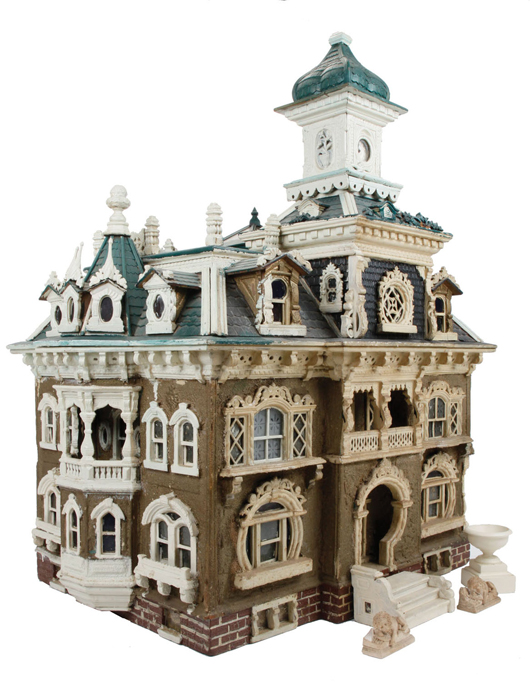
Extravagantly detailed Moorish Revival Christmas Garden House with stained, textured and etched window glazing. Est. $3,000-$5,000. Noel Barrett Auctions image. 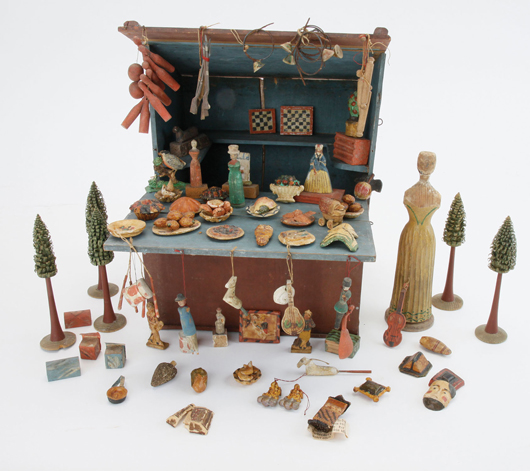
German Toy Stall, formerly in the Washington Dolls’ House & Toy Museum, German, early 19th century, elaborately accessorized with antique miniatures (accessories to be auctioned separately). Est. $6,000-$9,000. Noel Barrett Auctions image. 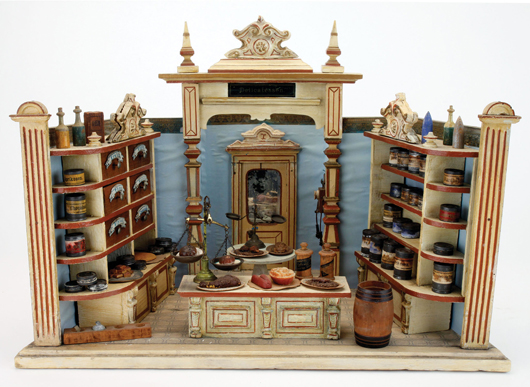
Gottschalk Delicatessen, late 19th century, painted wood and composition shop with miniature labeled tins and composition food items (accessories to be auctioned separately). Est. $2,500-$3,500. Noel Barrett Auctions image. 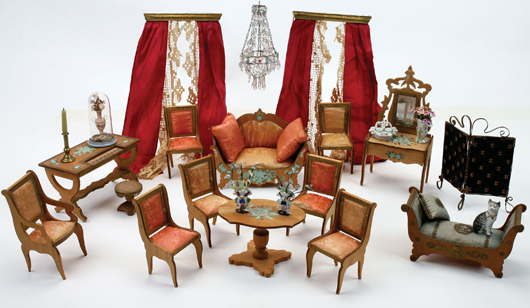
Louis XVI-style room furnishings, including parlor suite, upholstered sleigh bed, silk-paneled screen, silk and lace curtains, and many other pieces. Est. $900-$1,500. Noel Barrett Auctions image. 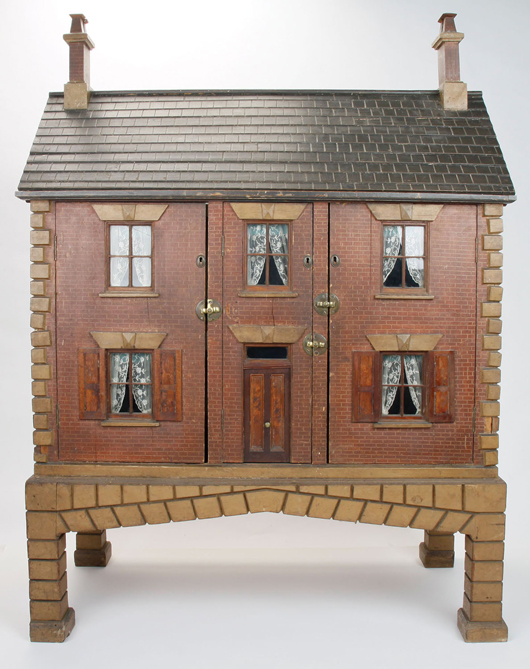
English Baby House, early to mid 1800s, featuring double chimneys with capped pots, scrolled arches under side eaves, shutters and beveled lintels. Est. $8,000-$12,000. 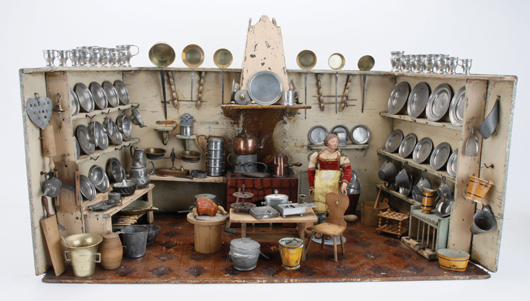
Circa-1800 Nuremberg Kitchen with painted faux-brick stove, shelving for display of miniature pewter, brass and wood accessories, including many rare examples (accessories to be auctioned separately). Est. $5,000-$8,000. Noel Barrett Auctions image. 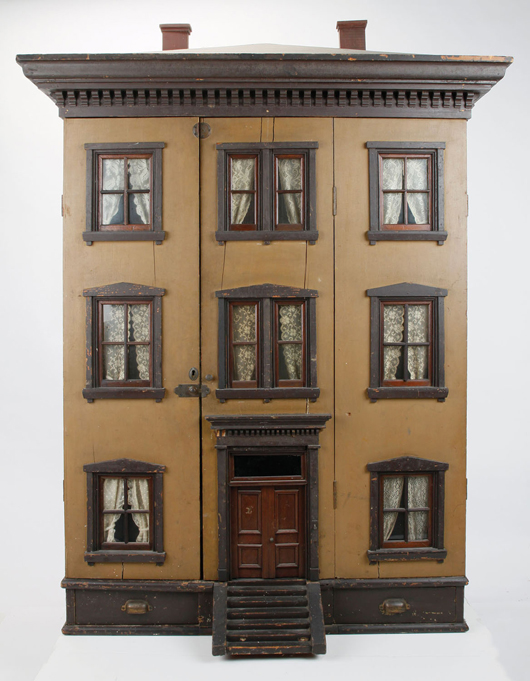
The Somerville (Mass.) Mansion, American Victorian, circa mid to latter-19th century, similar in form to the famed Tiffany-Platt House, described by auctioneer Noel Barrett as “one of the most celebrated houses in the Jacobs collection.” Est. $10,000-$15,000. Noel Barrett Auctions image. 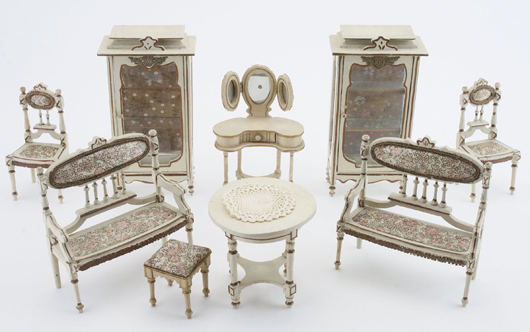
Leonhardt Parlor Suite, early 20th century, white painted wood with floral silk upholstery and gilt edging. Est. $800-$1,200. Noel Barrett Auctions image. 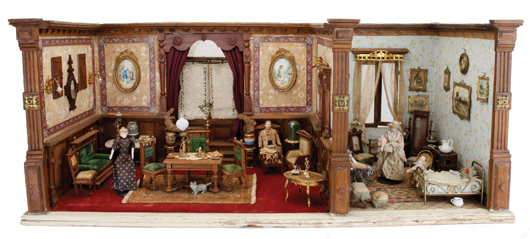
Set of Victorian period rooms, German, richly detailed with oak paneling, brass-ornamented pilasters, dentilated crown molding. The lavish accessories will be auctioned separately. Est. $4,000-$6,000. Noel Barrett Auctions image. 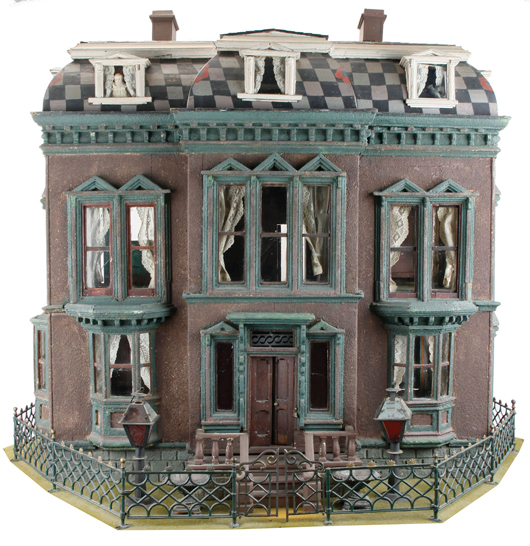
Centerpiece of the auction: The South Jersey House, circa 1870, the first house acquired by Flora Gill Jacobs and one that she chose to keep for her personal collection when the Washington Dolls’ House & Toy Museum closed and its contents were sold. Est. $12,000-$18,000. Noel Barrett Auctions image. 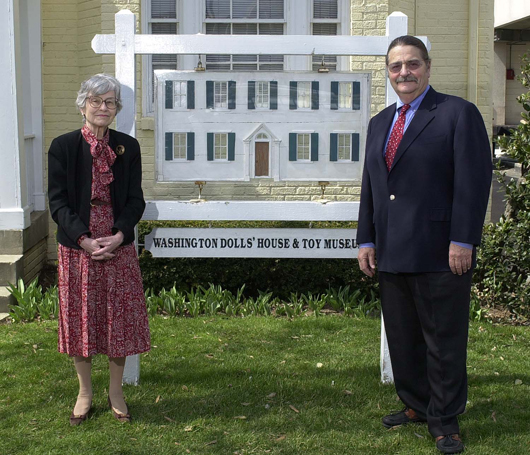
2004 photograph of Flora Gill Jacobs and Noel Barrett in front of the Washington Dolls’ House & Toy Museum. Photo was taken shortly before Barrett’s auction of the museum’s contents. Noel Barrett Auctions image.


